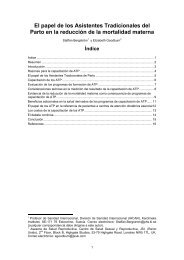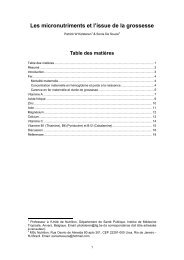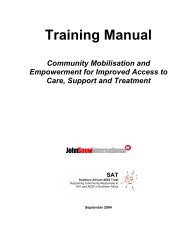book for PDF - John Snow International Europe
book for PDF - John Snow International Europe
book for PDF - John Snow International Europe
You also want an ePaper? Increase the reach of your titles
YUMPU automatically turns print PDFs into web optimized ePapers that Google loves.
Soil improvement <strong>for</strong> vegetable and fruit areasFertility trenchesUse these <strong>for</strong> disposing ofmaterial that is too rough <strong>for</strong>composting such as thornybranches and twigs. The bedsbecome more fertile as thematerial breaks down.• Dig a trench about 2mlong by 1m wide by 1mdeep. Separate the topsoil and subsoil intopiles as you dig.• Fill the trench with organicmaterial, e.g., food scraps, twigs and branches, leaves,grass and, old bones. Avoid plastic.• Replace the soil, putting the subsoil first and then the topsoil.Mulch the bed and plant vegetables.Livestock manureAnimal waste contains lots of nitrogen, the main nutrient <strong>for</strong> plantgrowth. Fresh chicken manure contains high levels of nitrogen. Rabbitand horse manure are low in nitrogen. Fresh chicken manure will burncrops. Use it in compost with lime to reduce acidity. Keep chickens orrabbits close to the home and use the manure in the garden. Poultry inmoveable units can be used to clear the land of vegetation and weedsand improve the soil with their manure.Liquid manureThere are two ways to make liquid manure. Either half-fill a sack withanimal manure then hang it in a drum full of water <strong>for</strong> about one week.Or collect leaves from leafy green plants such as weeds, comfrey,elderflower, stinging nettles or amaranth. Fill a drum or container with55






